|
|
Inspired by and dedicated to Dave Lee, May 7, 2014
Updated as per James P. Tuttle's The Hawk Moths of North America, May 7, 2014
Updated as per BAMONA, May 7, 2014
|
Granite County, Western Montana
Sphingidae
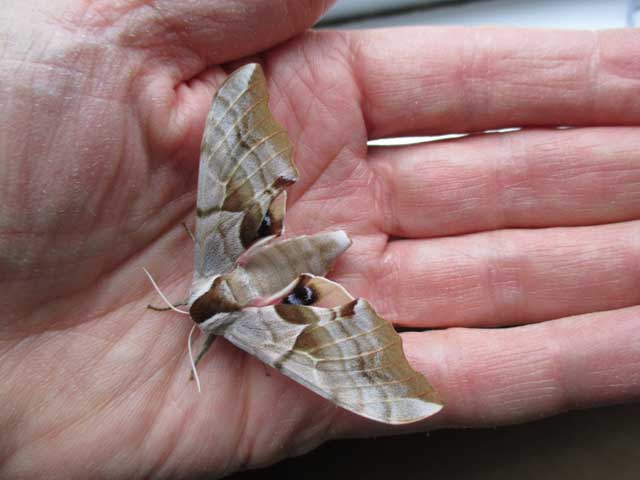
Smerinthus ophthalmica, Phillipsburg, Granite County, Montana,
May 2, 2014, courtesy of Dave Lee.
This page is inspired by and dedicated to Dave Lee, who sent me the S. ophthalmica image directly above.
Dave writes, "Love your site. Helped me to figure out what I have here.
"I caught the caterpillar galloping accross my driveway last October. I put it in a cardboard box and it promptly converted itself into a pupa.
I put the pupa in my refrigerator over the winter, setting out in an indoor planter in early April. It just hatched last Friday! Very cool.
Evidently they don't feed. Lots of Willow around here so that must explain its presence, but, in thirteen years I've never seen one before so perhaps they
are rare?
"Thanks for taking the time to create such a wonderful site."
I reply, "Thanks for thinking of me, Dave, and for sending this beautiful image of a fresh Smerinthus ophthalmica.
You handled the overwinter storage just right and were rewarded with a beautiful moth, and you are correct, this species does not feed in the adult stage.
"I do not think they are rare. I get many reports of them further west, especially from British Columbia, Canada and Washington state. You are
probably close to their easternmost range in the US. Further to the east you would more likely have seen Smerinthus cerisyi, a very close relative."
Dave added that the planter was an indoor planter near a sunlit window. It is probably too cold this time of year in Montana for any Sphingidae to be flying.
Ten Sphingidae species are listed for Montana on the USGS (now BAMONA) checklist. I have added some species to Montana which I feel are
likely present. Not all of the species are reported or anticipated in Granite County (none are reported on BAMONA as of May 7, 2014).
It is hoped that this checklist, with the thumbnails and notes, will help you quickly identify the moths you have encountered.
A "WO" after the species name indicates that I have no confirmed reports of this species in Granite County, but I
(William Oehlke) expect that this moth is present or might be present. A
BAMONA indicates the moth is reported on the BAMONA website and/or in Moths of Western North America,
#2. Distribution of Sphingidae of Western North America, revised, an excellent little booklet available through Paul Opler.
Please help me develop this list with improved, documented accuracy by sending sightings (species, date, location), preferably with an
image, via email to Bill Oehlke.
I have utilized James P. Tuttle's distribution maps, as posted in his excellent book, The Hawk Moths of North America, 2007, to assist with development
of this checklist. I have included several species which I have listed as remote possibility because they are slightly outside
the range indicated by Tuttle's book.
Please also send your sightings to BAMONA, an excellent online resource.
Visit Granite County Sphingidae Larvae: Caterpillars; Hornworms
Visit Montana Catocala: Underwing Moths
Sphinginae subfamily
Sphingini tribe:
 |
Manduca quinquemaculatus
WO, Five-spotted Hawkmoth:
Abdomen usually has five but sometimes six pairs of yellow
bands. Fw upperside: blurry brown; gray.
"Tomato Hornworms" feed on tomato; remote possibility
|
 |
Sphinx chersis
WO, Northern Ash Sphinx or Great Ash
Sphinx: Fw upperside:soft dark gray to
blue-gray with series of black dashes, one of which reaches
wing tip.
Larval hosts are ash, lilac, privet, cherry, quaking aspen.
remote possibility
|
 |
Sphinx drupiferarum larvae hide in the day and feed primarily on
cherry, plum, and apple at night.
|
 |
Sphinx luscitiosa
WO,
the Canadian Sphinx or
Clemen's Sphinx
The upperside of the forewing is yellowish gray in males and pale
gray with a faint yellow tint in females. In both sexes, the dark
border on the outer margin widens as it approaches the inner margin.
remote possibility
|
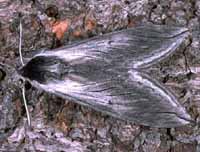 |
Sphinx perelegans WO, the Elegant Sphinx:
Sphinx perelegans adults fly in montane woodlands and mixed chaparral-type vegetation as a single brood
in the north, with adults mainly on the wing in June and July.
It flies from dusk until after midnight. remote possibility
|
 |
Sphinx vashti *
WO, the Snowberry Sphinx
The upperside of the forewing has a narrow black subterminal line
bordered by a white inverted V-shaped line on the outside, and a
black line running inwards from the apex of the wing.
It is most often found in montane woodlands and along streamcourses.
|
Smerinthini Tribe:
 |
Pachysphinx modesta *
WO,
the Modest Sphinx or Poplar Sphinx,
This moth has a large, heavy body, and females
can be remarkably plump.
|
 |
Pachysphinx occidentalis *
WO,
Big Poplar Sphinx:
Quite similar to Pachysphinx modesta, with modesta
being smaller and darker. Two color forms: the upperside of the forewings is yellow brown in the pale form and dark gray in the dark form.
Lines and bands are well-defined.
|
 |
The grey-blue eyespot of the hindwing gives this species its name.
Larvae feed on birches, willows, cherries and oaks.
The outer edge of the forewings is quite scalloped.
|
 |
Paonias myops * WO,
the Small-eyed Sphinx
This small species is probably widespread and common. This species ranges across North America.
The hindwings have a small blue eyespot ringed with black on a yellow background.
|
 |
Smerinthus cerisyi *
??, the Cerisyi's
Sphinx: possibly replaced by ophthalmica in western Montana.
If you have willows and poplars nearby, you've probably got
populations of
the Cerisyi's Sphinx. The hindwings are quite striking.
|
 |
Smerinthus jamaicensis not supposed to be present
WO, the Twin-spotted Sphinx:
Smerinthus jamaicensis closely resembles Smerinthus cerisyi, but
jamaicensis is much smaller with larger blue patches on
more vibrant and deeper purple in the lower wings. remote possibility
|
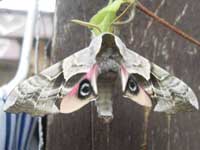 |
Smerinthus opthalmica
DL:
Larvae feed on poplars, aspen and willows.
Note different shape of double arced forewing pm line compared to the straighter pm line of cerisyi, two moths above.
S. ophthalmica has smoother scalloping of the fw outer margin.
|
Smerinthus opthalmica, Phillipsburg, May 2, 2014, Dave Lee
Macroglossinae subfamily
Dilophonotini tribe
 |
Hemaris diffinis *
WO,
the Snowberry Clearwing or Bumblebee Moth
The wings are basically clear, with dark brown to brownish-orange
veins, bases and edges. The thorax is golden-brown to dark
greenish-brown. The abdomen tends to be dark (black) with 1-2 yellow
segments just before the end.
|
 |
Hemaris senta WO * Rocky Mountain
clearwing
This moth is a day flier in mountain meadows. It is easily confused
with Hemaris diffinis and may actually be a form/variation of that species.
|
West of the Continental Divide, Hemaris diffinis is usually replaced by Hemaris thetis, and I believe
H. senta is generally regarded as a junior synonym of H. thetis. Hemaris thetis is probably the only
clearwing encountered in Ravalli County.
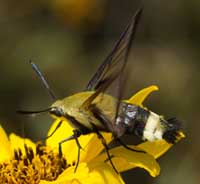 |
Hemaris thetis WO, the Thetis Clearwing or Bee Hawk Moth,
The moth flies along forest edges and in meadows, gardens and
brushy fields. Day-flying adults nectar at lantana, dwarf bush honeysuckle,
snowberry, orange hawkweed, thistles, lilac, Canada violet, etc.
|
Macroglossini tribe
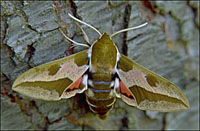 |
Hyles euphorbiae
WO the Spurge Hawk Moth
The body is light brown with various white and dark brown
markings, while the wings have a conspicuous tan, brown, and pink or
red color pattern.
probably will expand there if not already present
|
 |
Hyles gallii *
WO, the Bedstraw Hawk Moth or Gallium Sphinx
This species is not officially reported from Cascade County; however,
if you have Gallium or Epilobium, you probably have
populations of this species.
|
 |
Hyles lineata *
WO, the White-lined Sphinx
This species is very widespread. It can be seen flying during the day,
into the evening and also at night.
The highly variable larvae are often found in people's gardens.
|
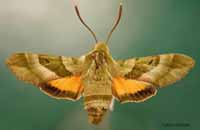 |
Proserpinus clarkiae WO, Clark's Sphinx:
Adults fly in the afternoon from April-June in oak woodland and
pine-oak woodland in foothills, nectaring from chia, heartleaf
milkweed, golden currant, bluedicks, fairyfans, vetches,
thistles, hedgenettles, etc. remote possibility
|
 |
Proserpinus flavofasciata WO , the Yellow-banded Day Sphinx:
Proserpinus flavofasciata adults fly from
April-June in meadows in coniferous forests. Adults fly during the
afternoon, nectaring from lilac, dandelion, cherry, etc.
|
|
|
Enjoy some of nature's wonderments, giant silk moth cocoons.
These cocoons are for sale winter and fall. Beautiful Saturniidae moths will emerge the following spring and summer.
Read Actias luna rearing article.
Additional online help available.
Eggs of many North American species are offered during the spring and summer. Occasionally
summer Actias luna and summer Antheraea polyphemus cocoons are available. Shipping to US destinations is done
from with in the US.
Use your browser "Back" button to return to the previous page.
This page is brought to you by
Bill Oehlke and the
WLSS. Pages are on space rented from Bizland. If you would like
to become a "Patron of the Sphingidae Site", contact Bill.
Please send sightings/images to Bill. I will do my best to respond to
requests for identification help.
 | 
Show appreciation for this site by clicking on flashing butterfly to the left.
The link will take you to a page with links to many insect sites. |
This website has been created and is maintained by Bill Oehlke without government or institutional financial assistance. All expenses, ie., text reference
support material, webspace rental from Bizland, computer repairs/replacements, backups systems, software for image adjustments (Adobe Photoshop; L-View),
ftp software, anti-virus protection, scanner, etc. are my own.
I very much appreciate all the many images that have been sent to me, or of which I have been granted permission to copy and post from other websites.
All images on this site remain the property of respective photographers.
If you would like to contribute to the maintenace of this website by sending a contribution to
Bill Oehlke
Box 476
155 Peardon Road
Montague, Prince Edward Island, C0A1R0
Canada
your donation would be much appreciated and would be used for
1) paying for webspace rental;
2) paying for computer maintenance and software upgrades;
3) purchases of additional text reference material (journals and books) in anticipation of expanding the site to a worldwide Sphingidae site;
4) helping to pay my daughter's tuition (completed spring 2013); with anything left over going to humanitarian aid.
If you are mailing a check from USA, please use $1.15 postage (2015 rate). Donations can also be made through Paypal via the button below.


